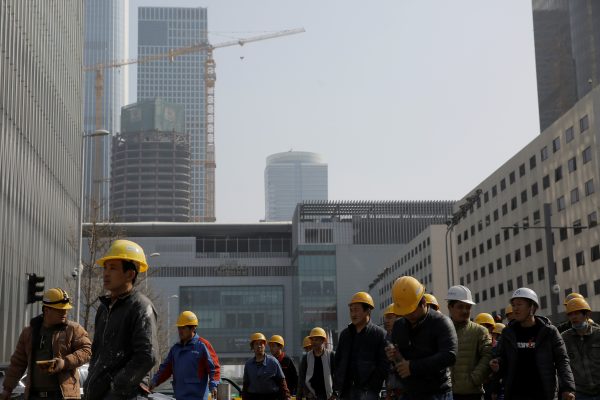But a wiser move would be to implement a more balanced macroeconomic approach that responds to the slowdown without posing a risk to the achievement of more sustainable and high-quality growth in the long run.
Several reasons explain China’s slower rate of economic expansion. These include China’s fading demographic dividend, sluggish total factor productivity performance as the economy approaches the technology frontier, a lack of reform in certain key areas such as the state-owned enterprise and financial sectors, rebalancing efforts to drive the economy’s transition from resource-intensive to high-quality growth, and trading partners’ protectionist reactions to China’s ascent.
The rebalancing efforts include an anti-corruption campaign, enforcement of the labour contract law, the strengthening of environmental protection measures, and — perhaps most importantly — the implementation of policies to deleverage the economy from a path of rapid debt growth and looming financial risk.
The deleveraging policies started in 2016 and have successfully prevented the acceleration of debt growth. Regulation of the shadow banking system has also helped to reduce risky financial lending and borrowing that may not be efficiently channelling funds into the real economy.
These supply-side reform policies help to wean ‘zombie firms’ off credit that could be put to more efficient and productive use. The goal is to move the economy towards better resource allocation and higher economic efficiency and productivity in the long run. To this end, more fundamental reforms to the capital market and further maturing of the financial system are required, and the deleveraging efforts are necessary.
But even sound policies can be a double-edged sword, especially in China — a transition economy with a highly complex and constantly evolving macroeconomic setting. Deleveraging leads to slower credit growth, subdued investment and consumption, and consequently slower economic growth. If credit growth declines too fast, economic growth may even fall below potential growth — leading possibly to recession.
The declining saving rate is also complicating the picture. China’s national saving rate has been falling continuously since 2010 as the population ages and consumption rises. This has led to a smaller current account as a share of GDP compared with that in the five years before the global financial crisis.
As China maintains a fixed exchange rate, the People’s Bank of China needs to purchase foreign currencies from Chinese exporters, which serves as a direct channel to inject money supply into the economy. When the current account declines, money supply through this mechanism falls and the banking system must compensate for the fall by providing more credit via loans. But when deleveraging policies crack down on shadow banking, credit expansion is slowed instead, which could hamper growth in the real economy if the current account continues to shrink.
Faced with a sluggish economy, should deleveraging policies be reversed? The best approach is for China to continue the deleveraging effort in a structural and smooth way. A structural way means providing easier access to credit in productive sectors and further reducing credit expansion in unproductive ones. A smooth way means adjusting the pace of deleveraging in response to economic conditions: quickening it when the economy is booming and easing it during a downturn.
This more balanced approach will help to facilitate structural adjustment towards higher potential growth and economic efficiency in the long run, and in the meantime help to combat the cyclical downturn. A reversal of deleveraging efforts and supply-side reforms may boost growth, but the uptick will be short-lived and non-sustainable as dim long-run growth prospects eventually kick in.
What are the sectors that can undertake more debt growth? Private enterprises have the capacity to expand borrowing. Private investment grew healthily in 2018 at a year-on-year growth rate of 8.7 per cent, compared to 6.0 per cent and 3.1 per cent in 2017 and 2016, respectively. Private investment in the manufacturing industry scored a growth rate of 9.5per cent, higher than the national average by 0.8 percentage points.
Private investment growth may be due to resources gradually shifting from uncompetitive firms to competitive ones under the deleveraging policies. New credit expansion is also going towards more competitive private firms, fuelling their growth. When access to bank loans becomes more difficult, firms tend to switch to other types of financing, including bond or equity issuance.
The central government still has the capacity to increase its debt and pursue expansionary fiscal policies, given its relatively low debt burden compared to local governments because the central government has a higher share of revenue and a lower share of expenditure than local governments. Expansionary policies could include earlier and larger transfers to debt-ridden local governments, infrastructure funding and tax cuts.
While these may raise the deficit and add to the central government’s debt burden, they will help to stimulate economic activity and reduce the risk of debt default by local government and firms. Tax reduction may encourage consumption and investment, leading to a broader tax base and higher tax revenue. And investment in new areas, such as telecommunications, infrastructure for Industry 4.0, the Internet of Things or urban infrastructure, may offer higher returns than traditional investment projects like high-speed railways.
The World Bank’s Global Economic Outlook for 2019 points out that weaker-than-expected activity in the United States and China could have a severe impact on global economic prospects and increase the probability of an abrupt global slowdown. Implementing deleveraging policies in China in a structural and smooth way is critical for maintaining sustainable growth — not only China’s but the world’s too.
Ligang Song is a Professor and the Director of the China Economy Program at the Crawford School of Public Policy, The Australian National University.
Yixiao Zhou is a Fellow at the Crawford School of Public Policy, The Australian National University.

